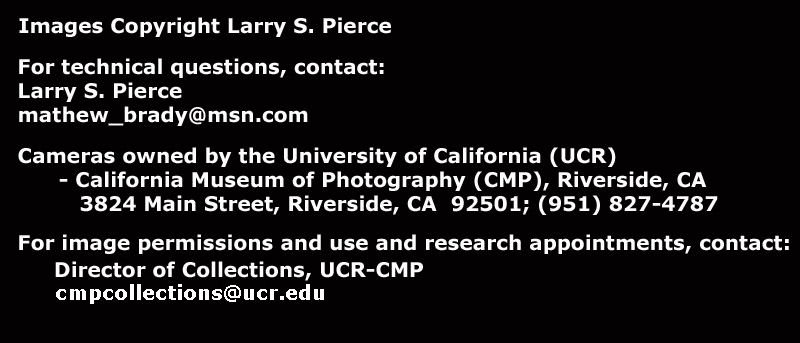How to Make Photographs and Descriptive Price List, Scovill Mfg. Co. (New York, NY), copyright 1886, ~5 ½"x9", 96pp
The
date of this catalog, 1886, is at a crossroads of photographic
technology for view cameras:
--This catalog still features a field carrying case
(the Corrugated Protective Case,
page 80) for the liquid chemicals required for the wet plate
process.
--Also present are numerous cameras, accessories, and
plates for the dry plate process, which had greatly replaced the wet
plate process by 1886.
--Finally, this is the first year of advertisements for
the
Eastman-Walker Roll Holder (pages
56 & 57).
The use of anything but glass plates in view cameras was a novel concept, so there is an extensive section describing how to use a roll holder (pages 11-24), and how to use carriers in dry plate holders (page 21). Roll and cut film as we know it was not yet invented - the roll holders and carriers were used roll and cut paper negatives.
In 1886, the sensitive layer in flexible film was gelatine-based, which was too thin or fragile to be used alone. The emulsion was therefore coated onto a substrate of paper, the the Eastman-Walker Roll Holder used rolls of Eastman's Negative Paper. After exposure, the paper would be cut into sheets and developed like cut film is today. For printing, the paper could be used in its translucent state, but printing was faster if castor oil or paraffin was ironed into the negative, thereby making it transparent.
Another product, Eastman's American Film (page 64), was stripping film requiring extensive manipulation after exposure, but which gave superior results to paper negatives. American Film was similar to Negative Paper in that paper was coated with a thin gelatine sensitive layer. The difference as that a layer of water-soluble gelatine was placed between the sensitive layer and the paper. After being exposed, cut into sheets, developed and fixed, the gelatine-gelatine-paper sandwich was placed on a sheet of glass, emulsion side down. Application of warm water dissolved the water-soluble gelatine, allowing the paper to be removed or stripped. The (still too thin) negative left on the glass was then reinforced with a thick layer of photographic negative varnish. The varnished negative was then robust enough to be removed from the glass.

1886lp935-covers-small.jpg)
1886lp935-ifc-01-small.jpg)
1886lp935-02-03-small.jpg)
1886lp935-04-05-small.jpg)
1886lp935-06-07-small.jpg)
1886lp935-08-09-small.jpg)
1886lp935-10-11-small.jpg)
1886lp935-12-13-small.jpg)
1886lp935-14-15-small.jpg)
1886lp935-16-17-small.jpg)
1886lp935-18-19-small.jpg)
1886lp935-20-21-small.jpg)
1886lp935-22-23-small.jpg)
1886lp935-24-25-small.jpg)
1886lp935-26-27-small.jpg)
1886lp935-28-29-small.jpg)
1886lp935-30-31-small.jpg)
1886lp935-32-33-small.jpg)
1886lp935-34-35-small.jpg)
1886lp935-36-37-small.jpg)
1886lp935-38-39-small.jpg)
1886lp935-40-41-small.jpg)
1886lp935-42-43-small.jpg)
1886lp935-44-45-small.jpg)
1886lp935-46-47-small.jpg)
1886lp935-48-49-small.jpg)
1886lp935-50-51-small.jpg)
1886lp935-52-53-small.jpg)
1886lp935-54-55-small.jpg)
1886lp935-56-57-small.jpg)
1886lp935-58-59-small.jpg)
1886lp935-60-61-small.jpg)
1886lp935-62-63-small.jpg)
1886lp935-64-65-small.jpg)
1886lp935-66-67-small.jpg)
1886lp935-68-69-small.jpg)
1886lp935-70-71-small.jpg)
1886lp935-72-73-small.jpg)
1886lp935-74-75-small.jpg)
1886lp935-76-77-small.jpg)
1886lp935-78-79-small.jpg)
1886lp935-80-81-small.jpg)
1886lp935-82-83-small.jpg)
1886lp935-84-85-small.jpg)
1886lp935-86-87-small.jpg)
1886lp935-88-89-small.jpg)
1886lp935-90-91-small.jpg)
1886lp935-92-93-small.jpg)
1886lp935-94-95-small.jpg)
1886lp935-96-ibc-small.jpg)